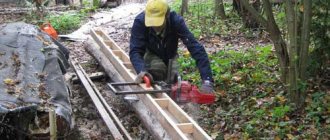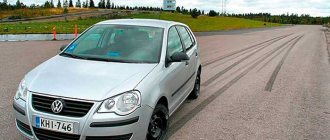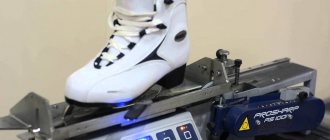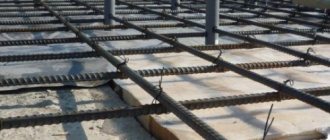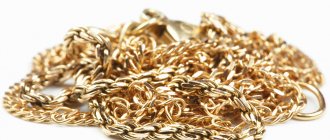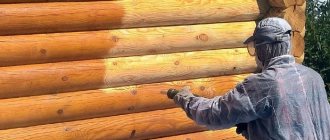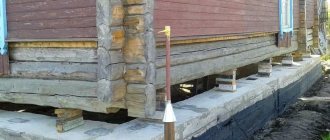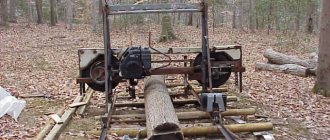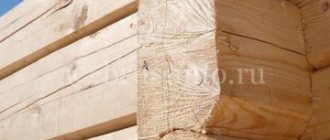Lumber cutting
Before cutting logs in a band sawmill, preparatory calculations should be made. It is necessary to take into account the direction of the cutting planes, the property of the wood, the number, as well as the volume of the upcoming product.
The variety of material can complicate the problem. For this reason, in order to prevent defects, a diagram of cutting the log trunk is made in advance.
After the log is fixed in the sawmill blade, a calculation is made based on the number of upcoming products.
For this purpose, appropriate measurements are created:
- In thoughts, wood is divided into 4 parts, and any one is also considered separately. A high-quality border is one that is free of damage, mold, chipping, and defects with insects. The best materials are made from it. The bars are often sawed from a plank removed from the worst side of the log.
- In the line of the sawmill, the volume is set to the diameter of the prepared part. The height of the unevenness is added to this value. It involves a difference in diameter among the apex, as well as the butt component.
- Use a tape measure to measure the height of the top of the log. Based on this value, the initial volume of the upcoming materials is calculated, including an allowance for sawing of 2 - 5 millimeters.
- Then, they turn the log 90 degrees, and also create similar calculations.
- The workpiece is unfolded in such a way that when sawing, the minimum number of slabs comes out.
After all the required measurements without exception have been made, and a diagram for cutting the log has been drawn up, it is necessary to decide on the sawing technology.
SAW CROSSLY
For cutting at an angle, an aluminum corner 50 x 50 x 2 mm was useful. I press it with clamps to the board that needs to be sawed. In this case, it is necessary to take into account the distance from the edge of the saw base to the saw blade.
Instead of a corner, I sometimes used a rectangular aluminum profile 40 x 20 x 2 mm, 1 m long.
One day I found an old locksmith’s corner with a steel shelf in the barn. With its help, it turned out to be convenient to make cuts at right angles, since the shelf is well fixed at the edge of the board.
Log cutting methods
Before sawing an entire forest, longitudinal cuts are made along the sides of the log, rarely from absolutely all edges. The released material is used to make double-edged timber, as well as unedged planks.
By changing the direction of the saw in relation to the annual rings in the log, it is possible to purchase timber with a unique pattern.
The properties of such planks will vary. This period is provided for when combining a log cutting scheme.
There are some types of sawing:
- Radial. Sawing is done vertically to the pattern of the rings. The section is valued because it produces a board with a uniform structure, as well as a color palette. It is highly resistant to moisture and shrinkage. This kind of material is high quality.
- Accelerator. Sawing of the log is carried out in parallel, or along the tangent line of relatively annual rings. The boards you buy are of low quality, but they have fascinating images. The materials are susceptible to high moisture and are recommended for use in dry conditions.
- Rustic. The section is made at different angles transversely to the log. The plank includes various imperfections in the form of knots and sapwood. It shows mediocre signs of shrinkage and swelling from moisture.
- Diametrical. The section is made in the middle of the log across the grain. The board has an image of a cross-section of annual rings. It stands out for its low quality.
In order to purchase the maximum number of materials at the lowest cost, it is possible to use special projects, or a drawing of a log cut in a band saw.
Preparing for cutting
Before sawing a log into boards, you need to remove the skin from it. This can be done with a sharpened shovel, scraper, or electric plane.
When using a shovel, the movements are done on your own.
It is believed that the best results are obtained when the bark is removed with a scraper - it does not affect the tree.
Cross cutting of logs
This is not difficult even for working at home. Place the log on the sawhorses or secure it to the guides. And you can saw off pieces of the desired size.
Work organization
At the beginning of the activity, it is recommended to sort the trees, since their direction depends on this. You should clean them of dirt, remove branches, as well as cloves.
The distribution is made according to the following aspects:
- Transverse trunk size;
- Bend;
- Number of knots, various damages;
- Diameter of the core.
Before sawing you should:
- Check the properties of fasteners, as well as combinations of elements.
- Check the presence of electricity.
- Lubricate surfaces subject to rubbing.
- Check the accuracy of the saw designs.
- Check the movement of the belt in idle and in the opposite process.
- If necessary, change the arrow of the sawmill by moving the roller from the left side edge by 5 - 10 cm.
SAW Lengthwise
If you need to straighten the edge of the board, you need a long guide. I use a rectangular profile 50 x 20 mm, 2 m long. If the board is shorter than 2 m, then it’s quite simple: we fasten the profile with two clamps and saw along it. But if the board is longer, then the profile needs its own guides and fastening. Can be fastened with two self-tapping screws. And I make a straight line using a strong thread, stretched like a string.
To fasten the thread, use a sharp knife to make a slit along the fibers at the required distance from the edge of the board at the beginning, and tuck the end of the thread there with a knot that prevents it from slipping out. At the other end there are two slits: in the upper one the thread is tensioned, and the lower one fixes it. If the tensioned thread oscillates when released and stops in the same position each time, then it is well tensioned.
We install the profile lengthwise at the same minimum distance without touching the thread and fasten it with self-tapping screws. To prevent the profile from moving during fastening, it must be pressed firmly. Having made the first pass with the saw, we rearrange the profile further. Ideally, another board of the same thickness should be placed under the other edge of the saw for support. If there is no such support, you will have to monitor the horizontal position of the saw, but this is easier than sawing in a straight line without a guide.
This way I was able to do an extreme leveling of a ceiling beam that had too much of a downward hump.
Sources:
https://stroy-podskazka.ru/brevno/kak-raspilit-na-doski-v-domashnih-usloviyah/ https://atmwood.com.ua/2018/01/30/kak-raspilit-brevno-na- doski/ https://kak-svoimi-rukami.com/2018/08/idealno-pryamoj-raspil-ruchnoj-cirkulyarkoj-moj-sovet/
Cutting technology
When selecting a technological process for sawing logs into planks, the properties and scale of the wood are taken into account.
There are 3 methods of activity at the sawmill:
- Sawing into collapse. The wood is sawn along a straight line to the end without any turns. At the exit, unedged planks are purchased. The disadvantage is the low quality of the purchased material, as well as a huge amount of residues. Purchased planks should also be trimmed. During operation there is a significant possibility of their cracking.
- Sawing in a circle. After the first sawing, the log turns to the opposite edge. Typically, there are five reversals. The method makes it possible to cut logs to scale with the least amount of residue. The disadvantages of this method include the low production rate.
- Sawing timber. The main part of sawing a log is done around the circumference. The main part is cut out in the shape of a beam. For this purpose, as a rule, the largest logs are used.
Cutting in a band sawmill is considered one of the most important stages of logging.
The properties of the purchased product directly depend on the chosen scheme, activity, as well as the preparation of the necessary equipment.
Briefly about the main thing
You can process wood on a circular saw with two types of discs. A simple and inexpensive monolithic one, as well as its analogue with carbide tips. The latter, although much more expensive, is much more effective. And passing it through any material gives a smoother and cleaner cut.
When purchasing a disk for your circular saw, you need to know the dimensions of the working shaft and protective casing. In order not to make a mistake with the choice of the outer and inner diameter of the cutting wheel. You should pay attention to the sharpening of the teeth and their configuration. If you often have to solve complex problems in your work, then these characteristics are very important.

